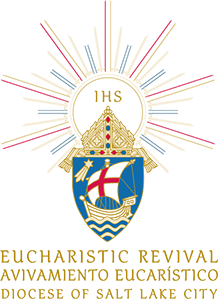Reflection 4: The Introductory Rites, Part II
(Editor’s note: This is one in a series of reflections on the importance of the Eucharist and what it means to be a Eucharistic people. These reflections are part of the Diocese of Salt Lake City’s participation in the National Eucharistic Revival, which began June 19 and will end in July of 2024 with the National Eucharistic Congress in Indianapolis. These reflections are designed to be read aloud at Mass by a priest, deacon or experienced minister following the Prayer after Communion. They will appear in print in this newspaper and on the diocese website, www.dioslc.org. The series of reflections will continue through June of 2023 in preparation for the July 9, 2023 Diocesan Eucharistic Rally at the Mountain America Expo Center in Sandy.)
After the initial greeting at Mass, we continue through the introductory rites. The second part of the introductory rites is called the penitential rite; in our introduction to this series of reflection that began a few weekends ago, we mentioned that there are ultimately four reasons why we gather together for Mass.
The first and primary reason is adoration. The second, and the one we will cover today, is contrition. The third is thanksgiving, and the fourth is supplication: asking him to reveal himself to us. For us to “unlock” the parts of the Mass that lead us to the Eucharist, we must acknowledge, confess, and ask forgiveness for our sins. This is the purpose of the penitential rite.
Think of times when you work extremely hard to make sure your living space or your working space is clean and pristine. The last thing you would want is for someone or something dirty to come and undo all the work you put into it. We should approach Mass in the same way.
God is pure and holy, and the Eucharist is unblemished. We would be harming ourselves and the community by approaching the Eucharist sinfully. This is why we must go to confession for any serious sins we have committed, and why we must ask for forgiveness for our personal sins.
We begin the penitential rite with the Confiteor, which cleanses us of our personal sins. In this part of the Mass, we prepare a spiritual purification for the rest of the Mass that is to follow by confessing that we have been guilty of personal sins against God and against the community. This is why we say in the Confiteor these words: “I confess to Almighty God and to you, my brothers and sisters ...” At the end of the Confiteor, we call upon those souls in Heaven who have undergone their final purification for strength in our earthly purification. We also call upon each other to pray for each other to God.
After the Confiteor, we sing the Kyrie. “Kyrie” is the Greek word for “Lord,” which is who we invoke: “Lord, have mercy.” We repeat the words of the priest or deacon when he says, “Lord, have mercy. Christ, have mercy. Lord, have mercy.” In the Kyrie, we are not only addressing Jesus Christ by calling him Lord, Christ, Lord. This unusual formula is an address to each individual person in the Holy Trinity.
The first part, “Lord, have mercy,” is asking the first person of the Trinity, God the Father, to have mercy on us. The second part, “Christ, have mercy,” is asking the second person of the Trinity, God the Son made man in the person of Jesus Christ, to have mercy on us.
The third part, “Lord, have mercy,” is asking the third person of the Trinity, God the Holy Spirit, to have mercy on us.
We do this in addition to the Confiteor because the Confiteor focuses on asking forgiveness from each other within the Church, which we refer to as the Mystical Body of Christ. The Kyrie, on the other hand, takes us a step further, asking God directly through all three persons of the Trinity.
We then collectively glorify God through the Gloria by modeling the words expressed by the angels at Christ’s birth: God has come down to be with us here on earth. This is a moment of celebration, joy and glory. Once again, we invoke the names of the three Persons of the Trinity, further establishing that the fullness of our faith and the fullness of God’s presence can be and is experienced throughout the Mass.
We end the penitential rite with a prayer spoken by the priest to God on behalf of the congregation. This prayer consolidates the desires of the congregation and our purpose for coming to God – it “collects” our prayer of petition as a community before we encounter the presence of Christ in a more substantial way in the next part of the Mass.
© Copyright 2024 The Diocese of Salt Lake City. All rights reserved.


Stay Connected With Us